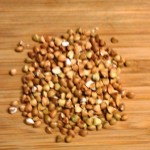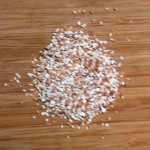Feb 13 2012
For Breakfast and Beyond – Buckwheat is Worth a Try
I often encourage my clients to try new foods, especially alternatives to the grain products we typically eat. One of my favorite grain alternatives has become buckwheat, not only because of it’s health benefits, but because of its versatility. Have you tried buckwheat yet?
Buckwheat flour is commonly added to commercial pancake mix, and this is how most people even know of its existence. However, buckwheat is much more than just an addition to a breakfast pancakes. In its lesser known forms, there are a lot health and nutritional benefits that could make buckwheat a wonderful addition to a “whole foods” diet.
Contrary to its name, buckwheat is not a form of wheat at all. Although it is sometimes referred to as a whole grain, it is, in fact a fruit seed that is related to rhubarb.
Whole buckwheat is a very nutritious food. The protein in buckwheat contains the eight essential amino acids. Buckwheat is also rich in many B vitamins as well as phosphorus, magnesium, iron, zinc, copper and manganese, and has Alpha-Linolenic Acid, which is one of the two essential fatty acids we must have in our diets.
In addition to its nutritional value, there are some a few health benefits that make this food worth your consideration:
- Buckwheat is a high fiber food. 1 cup of cooked buckwheat groats contains over 4 grams of dietary fiber.
- Because it is high in fiber and has a low glycemic load, it is a good carbohydrate choice for diabetes.
- Diets that contain buckwheat have been linked to lowered risk of developing high cholesterol and high blood pressure.
- Buckwheat is is a gluten-free alternative to grains, which makes it a healthful grain alternative for people with celiac disease or wheat sensitivity.
I find buckwheat products in the health food aisle of the grocery store, so you won’t need to search far to find it. Here’s a quick primer on the various forms of buckwheat readily available:
Buckwheat Groats: hulled grains of buckwheat, triangular in shape and resembles other grains. Buckwheat groats are used whole in hot cereals and soups. The seeds from buckwheat can be used to make flour after being removed from the husk.
Buckwheat Kasha: kasha, or roasted hulled buckwheat kernels, may be sold whole or cracked. You may find it ground into coarse, medium, or fine consistencies. The variety you use will depend on the consistency you need for the dish you are preparing.
Buckwheat groats and the roasted version, kasha are usually cooked in a manner similar to cooking rice. Either can be used to make hot cereal, added to soups or casseroles, or used as a side dish.
Buckwheat Flour: buckwheat flour can be used alone or mixed with other types of flours to make pancakes, breads, and muffins.
Buckwheat Soba: thin noodles made from buckwheat flour and typically served with a sauce.
So on your next trip to the grocery store, I hope you will look for buckwheat and give it a try. The Birkett Mills is the World’s largest manufacturer of buckwheat products, and their products are what I find in the grocery store. They are located in New York in the heart of the Finger Lakes. Next time, I’ll give you some recipe ideas for this wonderful food!
Comments Off on For Breakfast and Beyond – Buckwheat is Worth a Try

